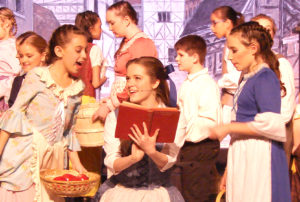Offering an ovation to student-actors and school programs
What started as an upbeat interview in an empty Milton High hallway about the successes of the school’s widely popular production of “Les Miserables” turned into a fairly serious discussion.
I asked senior performers Camden Choplick and Alaina Houtz what readers should know about the amount of work that goes into a production of this magnitude.
Alaina’s temperament changed quickly.
“Most people really don’t realize just how much work these shows can be. We put so much into it — not only time, but so much more,” she said. “What can be especially frustrating is that there is no budget for shows like ours from the school. We have to raise our own funds. We have to do it all.”
The concept isn’t a foreign one in the Valley. School budgets don’t typically allow for spring musicals. That means outside of the rehearsing, stage work, costume designing, choreography and other preparations that more than 500 students were faced with over the past year heading into an impressive spring slate of productions, these kids also needed to raise their own funds.
How much?
Laurie Knitter, director of Selinsgrove’s production of “Xanadu,” recently crunched some numbers.
Her students logged 170 hours of rehearsal time, and that doesn’t factor in the building of the sets, memorization of lines, costume creation, etc.
“The show itself cost approximately $6,600 to produce — $2,600 of that was in licensing fees for Music Theater International, the company that holds the rights to the show,” she said.
The theater department students raised almost $2,800 in advertising sales for the program. The rest, Knitter said, comes from ticket sales and donations.
How much school funding goes to theatric productions and the arts vs. other activities, such as sports or various clubs? I really don’t know.
What is completely apparent, though, after seeing a number of local musicals this spring and having the privilege of interviewing so many of our young talented actors and actresses is that they put just as much — if not more — heart, soul, sweat and tears into their performances as any other student in any other activity.
There are missed meals and homework blitzes in the middle of the night after long rehearsal sessions. There is tireless work on stage sets and costumes by parents and students alike. There is countless hours spent rehearsing lines in front of a bathroom mirror. There is all of that and so much more.
Our goal when developing the #ValleyMusicals movement was to give our local actors and actresses the credit they deserve. To let them know their efforts mattered.
They impressed us.
They inspired us.
This wasn’t just a matter of entertainment, but passion, and that devotion could be felt in large supply in each of our 12 Valley schools over the past two months.
Freelancer Tricia Kline sacrificed a number of weekends so she could attend every school’s show. But from what she told me, there really was no sacrifice at all. She was blessed to see so much talent at every show.
The information included in our #ValleyMusicals package is just a small glimpse of what happened at each school. Just the tiny, tiny tip of a very large iceberg.
Our are hats off to each student, parent and teacher involved — for the sacrifices made — and to each member of our local communities that made the effort to help these kids reach their goals.
It won’t be long until students are preparing for the 2017 spring musical season, and we are already making plans to take our #ValleyMusicals efforts to new heights.
For the time being, let’s all take a moment to give credit where credit is due — with the Alaina Houtz’s out there who know how much work and sacrifice is required to successful and still have the willingness to do what it takes to achieve true greatness.
Check out the full 24-page exclusive #ValleyMusicals package by clicking here.


